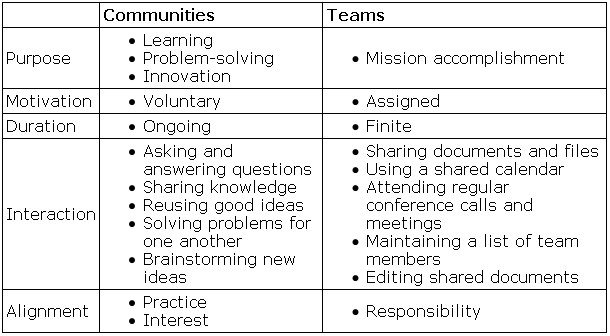Ne ho già parlato nel mio libro, a proposito dalle differenze che passano tra community e team virtuali, ma vale la pena riprendere l’argomento. Bill Ives riporta in un suo post i 10 principi di Stan Garfield per creare comunità di pratica di successo.
I 10 principi sono i seguenti
One – Communities should be independent of organizational structure. They should be based on the content.Two – Communities are different from organizations and teams. People are assigned to a team. Communities are better with self–selection for joining and remaining.
Third – Communities are people and not tools. You should not start with tech features. A platform is not a community. Readers of the same blog are not a community but that might be a byproduct.
Fourth – Communities should be voluntary. The passion of members should be what drives a community. You should make the community appealing to get members and not assign them to it.
Fifth – Communities should span boundaries. They should not be for a particular group likes Sales or IT. There is a lot of cross-functional or cross-geography learning that would be missed then. Diverse views help communities.
Sixth – You should minimize redundancy in communities. Consolidation helps to avoid confusion by potential members. It also reduces the possibility of not getting a critical mass. Reducing redundancy also enables more cross-boundary sharing.
Seven – Communities need a critical amass. You need at least 50 and likely 100. Usually ten percent are very active so you can get sufficient level of activity with 100 people.
Eight – Avoid having too narrow of scope for the community. Too much focus can lead to not enough members. Stan advises people to start broad and narrow if necessary. Or start as part of broader community and spin off if needed.
Nine – Communities need to be active. Community leaders need to do work, often in the “spare time” at their regular work. This means that the leader needs a passion for the topics so he or she will spend this extra time. There needs to be energy to get things going.
Ten – Use TARGETs to manage communities. TARGET includes: Types, activities, requirements, goals, expectations, and tools. Each of these issues needs to addressed and explained to prospective members. Tools are necessary, but the least important component, so they are placed last.
Insomma, in una community che si rispetti:
- le persone non sono scelte sulla base delle divisioni organizzative;
- le persone non si comportano come un team (compiti, scadenze, obiettivi definiti ecc);
- le persone ve3ngono prima della tecnologia;
- la partecipazione è volontaria;
- i confini sono “porosi”;
- non esistono sovrapposiziooni con altre community;
- si raggiunge una massa critica (minimo 50 persone);
- lo scopo è sufficientemente ampio;
- avvengono attività regolarmente;
- si usa il modello TARGET (types, activities, requirements, goals, expectations, and tools) per supportarle.
Qui trovate una presentazione che spiega in dettaglio i principi
Il lavoro di Stan Garfield è molto interessante, perché introduce una serie di elementi che cercano di distinguiere nettamente le caratteristiche delle community rispetto ad altri aggregati sociali, in particolar modo i team virtuali.
Ecco la tabella di Stan, tratta dal suo Communities manfiesto
Anche Bertrand Diperrin, dal canto suo, affronta l’argomento sul rapporto tra community e altre specie di fenomeni partecipativi.
A volte, dice, crediamo di aver creato una community, e invece siamo alle prese con qualcos’altro.
